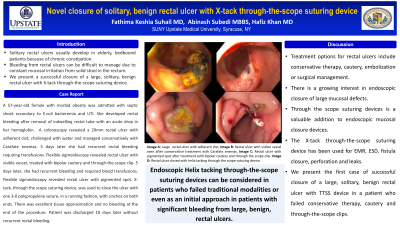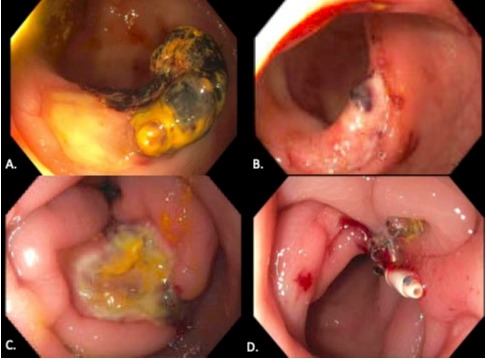Sunday Poster Session
Category: Interventional Endoscopy
P0866 - Tick, Tack, Close! Endoscopic Closure of Solitary Rectal Ulcer with X-tack Through-The-Scope Suturing Device
Sunday, October 22, 2023
3:30 PM - 7:00 PM PT
Location: Exhibit Hall

Has Audio
- FS
Fathima Suhail, MD
SUNY Upstate Medical University
Syracuse, NY
Presenting Author(s)
Fathima Keshia Suhail, MD, Abinash Subedi, MBBS, Hafiz M. Khan, MD
SUNY Upstate Medical University, Syracuse, NY
Introduction: Solitary rectal ulcers usually develop in elderly bedbound patients from chronic constipation. These patients usually present with minor bleeding however significant and recurrent bleeding can also occur. Bleeding from these ulcers is difficult to manage due to mucosal irritation from solid stool in the rectum. We demonstrate a novel approach of successful closure of a large, solitary, benign rectal ulcer with X-tack (Apollo Endosurgery, Austin Texas, USA) through-the-scope suturing device.
Case Description/Methods: A 57-year-old female with Roux-en-Y gastric bypass was admitted with shock secondary to urinary tract infection. She had rectal bleeding after removal of indwelling rectal tube. Her hemoglobin was 6.9 from a baseline of 12, platelets 62, white cell count 6.4, and INR 0.93. She was intubated, abdomen benign, no stigmata of cirrhosis, and rectal exam with brown stool coated with blood. Colonoscopy notable for a 20 mm rectal ulcer with adherent clot, challenged with water, and managed with Carafate enemas. 3 days later, she had recurrent rectal bleeding requiring transfusions. A flexible sigmoidoscopy revealed rectal ulcer with visible vessel, treated with cautery and through-the-scope clip. 5 days later, she again had recurrent bleeding. A flexible sigmoidoscopy revealed the rectal ulcer with pigmented spot. The X-tack, through the scope suturing device, used to close the ulcer with one 3-0 polypropylene suture, in a running fashion, with cinches on both ends, with excellent tissue approximation and no bleeding at the end of the procedure. The patient was discharged 10 days later without recurrent rectal bleeding.
Discussion: Treatment options for rectal ulcers involve conservative therapy, cautery, embolization, or surgical management. There has been a growing interest of closure of large mucosal defects endoscopically and includes through-the-scope clips, over-the-scope clips, over-the-scope suturing, and through-the-scope suturing (TTSS). TTSS is a valuable addition to mucosal closure. The X-tack TTSS has been used for closure of endoscopic mucosal resection, endoscopic submucosal resection, fistula closure, perforation, or leaks. We present the first case of successful closure of a large, solitary, benign rectal ulcer with a TTSS device in a patient who failed conservative therapy, cautery and through-the-scope clips. TTSS can be considered in patients who failed other modalities or even as an initial approach in patients with significant bleeding from large, benign, rectal ulcers,

Disclosures:
Fathima Keshia Suhail, MD, Abinash Subedi, MBBS, Hafiz M. Khan, MD. P0866 - Tick, Tack, Close! Endoscopic Closure of Solitary Rectal Ulcer with X-tack Through-The-Scope Suturing Device, ACG 2023 Annual Scientific Meeting Abstracts. Vancouver, BC, Canada: American College of Gastroenterology.
SUNY Upstate Medical University, Syracuse, NY
Introduction: Solitary rectal ulcers usually develop in elderly bedbound patients from chronic constipation. These patients usually present with minor bleeding however significant and recurrent bleeding can also occur. Bleeding from these ulcers is difficult to manage due to mucosal irritation from solid stool in the rectum. We demonstrate a novel approach of successful closure of a large, solitary, benign rectal ulcer with X-tack (Apollo Endosurgery, Austin Texas, USA) through-the-scope suturing device.
Case Description/Methods: A 57-year-old female with Roux-en-Y gastric bypass was admitted with shock secondary to urinary tract infection. She had rectal bleeding after removal of indwelling rectal tube. Her hemoglobin was 6.9 from a baseline of 12, platelets 62, white cell count 6.4, and INR 0.93. She was intubated, abdomen benign, no stigmata of cirrhosis, and rectal exam with brown stool coated with blood. Colonoscopy notable for a 20 mm rectal ulcer with adherent clot, challenged with water, and managed with Carafate enemas. 3 days later, she had recurrent rectal bleeding requiring transfusions. A flexible sigmoidoscopy revealed rectal ulcer with visible vessel, treated with cautery and through-the-scope clip. 5 days later, she again had recurrent bleeding. A flexible sigmoidoscopy revealed the rectal ulcer with pigmented spot. The X-tack, through the scope suturing device, used to close the ulcer with one 3-0 polypropylene suture, in a running fashion, with cinches on both ends, with excellent tissue approximation and no bleeding at the end of the procedure. The patient was discharged 10 days later without recurrent rectal bleeding.
Discussion: Treatment options for rectal ulcers involve conservative therapy, cautery, embolization, or surgical management. There has been a growing interest of closure of large mucosal defects endoscopically and includes through-the-scope clips, over-the-scope clips, over-the-scope suturing, and through-the-scope suturing (TTSS). TTSS is a valuable addition to mucosal closure. The X-tack TTSS has been used for closure of endoscopic mucosal resection, endoscopic submucosal resection, fistula closure, perforation, or leaks. We present the first case of successful closure of a large, solitary, benign rectal ulcer with a TTSS device in a patient who failed conservative therapy, cautery and through-the-scope clips. TTSS can be considered in patients who failed other modalities or even as an initial approach in patients with significant bleeding from large, benign, rectal ulcers,

Figure: Figure 1: Evolution of rectal ulcer. (A) Rectal ulcer with large adherent clot. (B) Rectal ulcer with visible vessel 3 days post conservative treatment. (C) Rectal ulcer with pigmented spot 5 days post cautery and through-the-scope-clip. (D) Rectal ulcer closure with X-tack through-the-scope-suture.
Disclosures:
Fathima Keshia Suhail indicated no relevant financial relationships.
Abinash Subedi indicated no relevant financial relationships.
Hafiz Khan indicated no relevant financial relationships.
Fathima Keshia Suhail, MD, Abinash Subedi, MBBS, Hafiz M. Khan, MD. P0866 - Tick, Tack, Close! Endoscopic Closure of Solitary Rectal Ulcer with X-tack Through-The-Scope Suturing Device, ACG 2023 Annual Scientific Meeting Abstracts. Vancouver, BC, Canada: American College of Gastroenterology.
